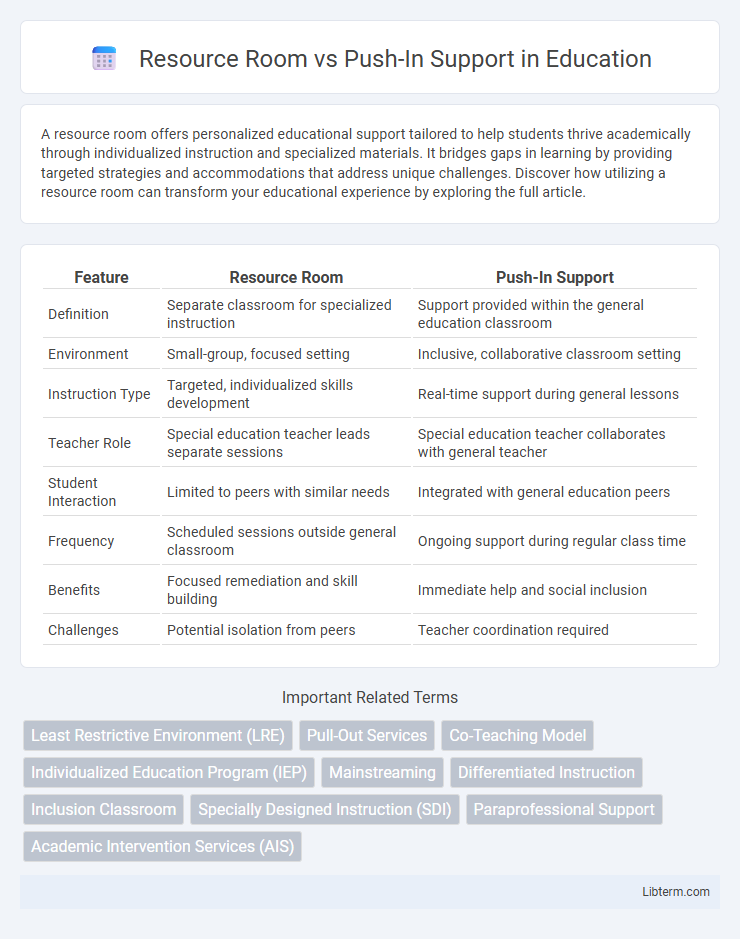A resource room offers personalized educational support tailored to help students thrive academically through individualized instruction and specialized materials. It bridges gaps in learning by providing targeted strategies and accommodations that address unique challenges. Discover how utilizing a resource room can transform your educational experience by exploring the full article.
Table of Comparison
| Feature | Resource Room | Push-In Support |
|---|---|---|
| Definition | Separate classroom for specialized instruction | Support provided within the general education classroom |
| Environment | Small-group, focused setting | Inclusive, collaborative classroom setting |
| Instruction Type | Targeted, individualized skills development | Real-time support during general lessons |
| Teacher Role | Special education teacher leads separate sessions | Special education teacher collaborates with general teacher |
| Student Interaction | Limited to peers with similar needs | Integrated with general education peers |
| Frequency | Scheduled sessions outside general classroom | Ongoing support during regular class time |
| Benefits | Focused remediation and skill building | Immediate help and social inclusion |
| Challenges | Potential isolation from peers | Teacher coordination required |
Understanding Resource Room Support
Resource Room support offers specialized, small-group instruction tailored to students with learning disabilities, providing targeted skill-building and personalized academic assistance outside the regular classroom. It emphasizes a structured environment where educators use diagnostic data to address individual student challenges through evidence-based interventions. This approach enhances focused learning by reducing distractions and allowing in-depth support in areas like reading, math, and executive functioning skills.
What Is Push-In Support?
Push-In Support involves specialized educators working directly within the general education classroom to provide targeted instruction and support to students with diverse learning needs. This approach promotes inclusivity by enabling immediate assistance without removing students from their peers, fostering collaborative learning environments. Research shows that Push-In Support enhances academic engagement and social integration compared to separate Resource Room sessions.
Key Differences Between Resource Room and Push-In
Resource Room services provide specialized, individualized instruction outside the general classroom, allowing students with learning challenges to receive focused support in a separate setting. Push-In Support delivers personalized assistance within the general education classroom, facilitating inclusion and enabling real-time support alongside peers. Key differences include the instructional environment, with Resource Rooms offering a pull-out model and Push-In Support emphasizing in-class collaboration and immediate intervention.
Benefits of Resource Room Services
Resource Room services provide targeted, individualized academic interventions in a controlled environment, enhancing student focus and retention of key concepts. This setting allows for tailored instruction addressing specific learning disabilities or challenges, resulting in improved skill mastery and confidence. Concentrated support in Resource Rooms fosters better progress monitoring and customized strategies, yielding measurable improvements in students' academic outcomes.
Advantages of Push-In Support
Push-in support allows educators to provide personalized intervention within the general education classroom, fostering inclusive learning environments and promoting social interaction among students. It supports real-time collaboration between special education and general education teachers, enhancing instructional strategies tailored to individual student needs. This approach minimizes student disruption by avoiding transitions to separate rooms, thereby increasing engagement and accessibility to the core curriculum.
How Schools Decide on Support Models
Schools determine support models based on individual student needs, evaluating academic skills, social-emotional factors, and IEP goals to decide between Resource Room and Push-In Support. Data-driven assessments and collaboration among special education staff, general educators, and families guide decisions to maximize effective inclusion and targeted interventions. District policies and available personnel resources also influence the feasibility of implementing either service delivery model.
Impact on Student Academic Performance
Resource Room support provides individualized, intensive instruction tailored to students with learning disabilities, leading to significant improvements in reading comprehension and math skills. Push-in support integrates special education services within the general classroom setting, promoting inclusion and real-time assistance, which enhances engagement and concept retention. Studies show that combining both approaches can maximize academic gains by addressing specific skill deficits while fostering social integration.
Social and Emotional Considerations
Resource Room support offers individualized attention in a separate setting, which can reduce social anxiety and provide tailored emotional support for students needing focused intervention. Push-In Support integrates assistance within the general classroom, fostering peer interaction and promoting social inclusion, which enhances emotional well-being and collaboration skills. Choosing between these models depends on the student's specific social-emotional needs, such as the desire for one-on-one support versus the benefits of social integration.
Teacher Collaboration and Training
Resource Room and Push-In Support models emphasize distinct approaches to teacher collaboration and training essential for effective special education. In Resource Rooms, teachers often collaborate through scheduled planning sessions dedicated to individualized instruction strategies and specialized training on tailored interventions. Push-In Support requires ongoing, dynamic collaboration and co-teaching skills, with professional development focusing on inclusive classroom management and real-time adaptation to diverse student needs.
Choosing the Right Support for Your Child
Selecting the right support for your child involves understanding the key differences between Resource Room and Push-In Support. Resource Room offers specialized, individualized instruction outside the general classroom, ideal for targeted skill development and intensive remediation. Push-In Support integrates assistance within the general education setting, promoting inclusion and real-time collaboration while enabling your child to access the general curriculum alongside peers.
Resource Room Infographic

 libterm.com
libterm.com